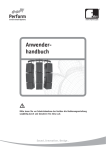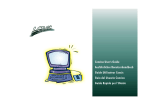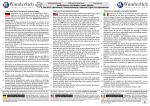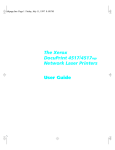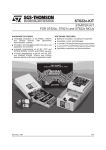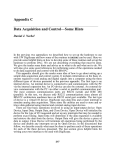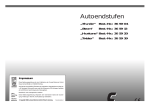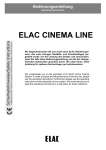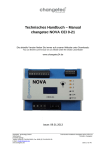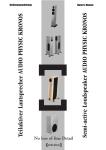Download Bedienungsanleitung
Transcript
i-soamp / Auxgate Car-Audio-Amplifiers and Multimedia Extensions by manual Germany intelligent solutions and technologies D i-soamp Medialink, i-soamp-4cx und Auxgate® Connect Wir beglückwünschen Sie zum Kauf dieses i-sotec Produktes und danken für Ihr Vertrauen! Mit diesem Car-Audio-Gerät haben Sie ein technologisch ausgereiftes und innovatives Produkt erworben, das Ihnen viele Jahre hervorragenden Musikgenuss ermöglichen wird. In i-sotec Produkten steckt die gesammelte Erfahrung unserer Ingenieure, Redakteure der Fachzeitschriften und nicht zuletzt auch Car-Audio-Händler, durch die wir viele Anregungen bekommen haben. Der i-soamp-4cx ist ein 4-Kanal Car-Audio-Verstärker, der speziell für den Einsatz in Fahrzeugen mit fest eingebautem (OEM) Autoradio konzipiert wurde. Eine komplette Adapterlinie ermöglicht den Anschluss ohne aufwendige Verkabelungsarbeiten bei mehr als 500 Fahrzeugtypen. Natürlich kann der i-soamp auch mit jedem handelsüblichen Autoradio betrieben werden. Es besteht außerdem die Möglichkeit, die Kanäle in Brücke zu schalten, um so mit mehr als der doppelten Leistung Subwoofer betreiben zu können. Die vielfältigen Einstell- und Anpassungsmöglichkeiten machen den i-soamp zum Allround-Genie im Auto. Der i-soamp Medialink verbindet die Klangqualität und die Anschlussmöglichkeiten des i-soamp mit der komfortablen Möglichkeit, externe Klangquellen anzuschließen und vollautomatisch zu verwalten. Das Auxgate® Connect bietet vollen Multimedia-Komfort für alle, die mit dem Klang ihrer Car-Audio-Anlage zufrieden sind und keinen leistungsfähigen Verstärker benötigen. Bitte lesen Sie vor Installation und Inbetriebnahme diese Anleitung sorgfältig durch, um Bedienungsfehler zu vermeiden. Im Zweifelsfall wenden Sie sich bitte an Ihren Fachhändler. BESTIMMUNGSGEMÄßER GEBRAUCH: i-soamp und Auxgate® sind ausschließlich für den Betrieb im Fahrzeug am 12V Kfz-Bordnetz und am Original-Lautsprecher-Kabelbaum sowie mit Original i-sotec Adapterkabeln und i-sotec Subwoofern (optional) vorgesehen. Andere Adapterkabel und Subwoofer können den i-soamp beschädigen. Der i-soamp nimmt die Audiosignale des OEM Radios auf und führt sie den Fahrzeuglautsprechern verstärkt wieder zu Inhalt: A Einbauanleitung, Fehlersuche, technische Daten B Bedienungsanleitung i-soamp-4cx C Bedienungsanleitung i-soamp Medialink D Bedienungsanleitung Auxgate® Connect i-soamp Medialink, i-soamp-4cx und Auxgate Connect UK Congratulations on your purchase of this i-sotec product, and thank you for your trust! With this i-sotec – amplifier you have acquired a technologically fully developed and innovative product that will give you many years of outstanding music enjoyment. i-sotec products contain the sum of experience gained over many years by our engineers, editors of specialist publications and not least the car audio dealers who have given us many ideas. The i-soamp Medialink was specifically designed for use in cars with integral (OEM) car radios. A complete adaptor range permits connections without elaborate cabling work to more than 500 vehicle models. The i-soamp can, of course, also be operated with any standard commercial car radio. Alternativlye the channels may be configured to bridge mode to enable a subwoofes to be operated with more than twice the output. The many adjustment and adaptation possibilities make the i-soamp an all-round genius for your car. The i-soamp Medialink combines the sound quality and easy connection of the isoamp series with the possibility to connect various audio sources to your car audio system and maximum listening comfort by a fully automatic managemant of these sources. For all those who are satisfied with their car audio’s sound, the Auxgate Connect provides full multimedia comfort without a powerfull amplifier. Please read these instructions carefully before installation and operation to avoid operating problems. If in doubt, please consult your specialist dealer. INTENDED USE: The i-soamp Medialink is exclusively intended for operation in a car with a 12V electrical system and the original loudspeaker cable harness. It takes the audio signals of the OEM radio and conducts the to the vehicle loudspeakers in amplified form. Content Of This Manual A Installation Guide, Troubleshooting, Technical Data B User’s Guide i-soamp-4cx C User’s Guide i-soamp Medialink D User’s Guide Auxgate Connect A INSTALLATION Achten Sie bei der Installation unbedingt auf eine gute Belüftung des Gerätes. Es darf nicht abgedeckt oder in der Nähe anderer Wärme abstrahlender Gegenständen montiert oder direkter Sonneneinstrahlung ausgesetzt werden! Der i-soamp kann sich selbst stark erwärmen (bis zu 80°C), daher ist auf ausreichenden Abstand zu anderen wärmeempfindlichen Fahrzeugteilen (insbesondere Kunststoffteile und elektronische Komponenten) zu achten! Aus Sicherheitsgründen muss das Gerät fest im Fahrzeug installiert werden. Befestigen Sie das Gerät mit den mitgelieferten Montageschrauben an einem festen und geeigneten Untergrund. Bohren Sie keine Löcher in Teile des Fahrzeuges, wenn Sie nicht wissen, was sich dahinter befindet. Achten Sie auf Kabelbäume und Benzinleitungen! D Lieferumfang Die i-sotec Car-Audio-Systeme werden mit folgendem Zubehör geliefert: 1. Verstärkereinheit 2. Controller (nur Medialink) 3. i-sotec Kabelbaum 4. Iso-Stromadapter 5. Handbuch A.1. ANSCHLUSS Der i-soamp oder das Auxgate® wird mittels original i-sotec Adapter direkt an den Fahrzeug-Kabelbaum und an das Originalradio angeschlossen. Bei Fahrzeugtypen ohne ISO Anschluss wird hierfür zusätzlich ein fahrzeugspezifischer Adapter benötigt. Überprüfen Sie bitte anhand der i-sotec Fahrzeugliste, ob Sie zum Anschluss des i-soamp an Ihrem Fahrzeug einen zusätzlichen Adapter benötigen. Sie können dies auch online unter http://www.i-sotec.com feststellen. A INSTALLATION When installing the equipment, be sure that it is well ventilated. It must not be covered or mounted near heat emitting objects or be subjected to direct sunlight. The i-soamp Medialink can heat itself up significantly (up to 80°C); it is therefore important to ensure sufficient clearance from other heat-sensitive vehicle components (particulary plastic-parts and electronic components)! For safety reasons, the device must be securely mounted in the vehicle. Attach the device with the supplied mounting screws to a firm and suitable base. Do not drill holes in parts of the vehicle if you are not sure what is located behind it. Watch out for wiring harnesses and fuel lines!!! UK A.1.Accessorys The i-soamp package includes the following accessorys: 1. Amplifier unit 2. Controller (Medialink only) 3. Wiring harness 4. Iso-power plug 5. Manual A.1 Connection The isoamp or Auxgate is connected directly to the vehicle cable harness and to the original radio with an adaptor. Vehicle models without an ISO connection require a special vehicle-specific adaptor for this purpose. Please consult the i-sotec vehicle list to check whether you need an additional adaptor to connect the i-soamp to your vehicle. You can do this online as well at http://www.i-sotec.com/ A1.1 Ist-Situation Entfernen Sie das Originalradio gemäß der Anleitung des Fahrzeugherstellers aus dem Radioschacht, damit Sie die rückseitigen Anschlüsse des Radios erreichen können. Wenn Ihr Originalradio einen ISO Anschluss hat, finden Sie – ggfs. neben anderen Anschlüssen wie z.B. dem Antennenkabel folgende zwei Stecker, die sich nach Zusammendrücken der seitlichen Verriegelung vom Radio entfernen lassen: D ISO-Stecker für den Lautsprecheranschluss (Bild 1) Dieser Stecker (im Folgenden als ISO-Lautsprecherstecker bezeichnet) ist daran zu erkennen, dass die Verriegelung mittig an der schmalen Seite des Steckers angeordnet ist. Abgesehen davon ist der Stecker meistens aus braunem Kunststoff und die anschließenden Lautsprecherkabel sind üblicherweise grau und weiß. Die Farbkodierungen werden allerdings nicht einheitlich bei allen Fahrzeugherstellern eingehalten und können variieren. ISO-Stecker für den Stromanschluss (Bild 2) Dieser Stecker (im Folgenden als ISO-Stromstecker bezeichnet) ist eindeutig daran zu erkennen, dass die Verriegelung nicht mittig an der schmalen Seite des Steckers angeordnet ist. Der Stecker ist meistens aus schwarzem Kunststoff .An diesem Stecker schließen üblicherweise ein rotes, ein schwarzes, ein gelbes sowie weitere farbige Kabel an. Die Gegenstücke zu den ISO-Steckern sind die ISOKupplungen (Bild 3). Die ISO-Kupplung für den Lautsprecheranschluss (ISO-Lautsprecherkupplung) lässt sich nur mit den passenden ISO-Lautsprechersteckern verbinden. Die entsprechende Nut mittig an der schmalen Seite der Kupplung stellt dies sicher. Die ISO-Kupplung für den Stromanschluss (ISO-Stromkupplung) lässt sich ebenfalls nur mit den passenden ISO-Stromsteckern verbinden. Auch hier stellt eine entsprechende Nut seitlich an der schmalen Seite der 4 Kupplung dies sicher. Bei den meisten Radios sind diese Kupplungen direkt im Gehäuse als „Steckdosen“ integriert. Um die vorhandenen ISO-Stecker, die sich am Kabelbaum des Fahrzeugs befinden mit dem i-soamp zu verbinden, werden die beiden hier abgebildeten ISO-Kupplungen am i-soamp Kabelbaum verwendet: ISO-Lautsprecherkupplung am i-soamp Kabelbaum (Bild 4) ISO-Stromkupplung am i-soamp Stromadapter (Bild 5) A.1.1: Situation as is: Remove the original radio from the radio slot according to the vehicle manufacturer's instructions so that you can get to the terminals on the rear side of the radio. If your original radio has an ISO terminal – possibly next to other terminals such as the antenna cable - you will find the following two plugs which can be removed after pressing together the locking mechanism on the side: UK 1 ISO plug for the loudspeaker connection (Pic. 1) This plug (below also referred to as the ISO loudspeaker plug) can be clearly identified by the fact that the locking mechanism is located in the center of the narrow side of the plug. Apart from that, the plug is usually made of brown plastic and the connected loudspeaker cables are typically grey and white. 2 The color coding, however, is not uniformly maintained by all vehicle manufacturers and can vary. ISO plug for the power connection (Pic. 2) This plug (below also referred to as the ISO power plug) can be clearly identified by the fact that the locking mechanism is not located in the center of 3 the narrow side of the plug. Apart from that, the plug is usually made of black plastic and typically a red, a black, a yellow and additional colored cables are connected to this plug. The color coding, however, is not uniformly maintained by all vehicle manufacturers and can vary. The mating parts for these ISO plugs are called ISO receptacles (Pic. 3). The ISO receptacle for the loudspeaker connection (ISO loudspeaker receptacle) can only be connected to the matching ISO loudspeaker plugs. The ISO coupling for the power connection (ISO power receptacle) can also only be connected to the matching ISO power plugs. Here, too, a corresponding groove located on the side of the coupling ensures the correct connection. In most radios these receptacles are directly recessed in the housing as Terminals. Use the two ISO couplings on the i-soamp cable harness shown here to connect the existing ISO plugs, located in the vehicle's cable harness, to the i-soamp: ISO loudspeaker receptacles on the i-soamp cable harness (Pic. 4) and ISO power receptacle on the i-soamp power adaptor (Pic. 5). 5 A.1.2 Überblick: Anschlussprinzip Diese Darstellung soll Ihnen einen Überblick verschaffen, wie der isoamp und das Auxgate® Connect grundsätzlich mit den Komponenten in Ihrem Fahrzeug verbunden werden. Folgende Schritte sind notwendig, um den i-soamp oder das Auxgate® an Ihrem vorhandenen Autoradio anzuschließen: 1. i-soamp-Kabelbaum mit dem Kompaktstecker am i-soamp oder Auxgate® anschließen. 2. Stromstecker am i-soamp-Kabelbaum mit der Kupplung des mitgelieferten Stromadapters verbinden. 3. ISO-Lautsprecherkupplung des Fahrzeug-Kabelbaums vom Radio lösen und an der ISO-Lautsprecherkupplung (braun) des isoamp Kabelbaums verbinden. (Details zu Anschlussvarianten siehe Kapitel A.1.3, A.1.4, A.1.5) 4. Die ISO-Stromkupplung des Fahrzeug-Kabelbaums vom Autoradio lösen und an der ISOStromkupplung (schwarz) des mitgelieferten Stromadapters verbinden (Details zum Stromanschluss siehe Kapitel A.1.6 und A.1.7) 5. Den ISO-Stromstecker (schwarz) des mitgelieferten Stromadapters mit der ISO-Stromkupplung des Autoradios verbinden. 6. Den ISO-Lautsprecherstecker (braun) des i-soamp-Kabelbaums mit der ISO-Lautsprecherkupplung des Autoradios verbinden. Lesen Sie auf jeden Fall die folgenden Kapitel, bevor Sie mit dem Anschließen beginnen, um die Details der einzelnen Anschlussvarianten zu erfahren. D Alternativer Anschluss über Cinch-Kabel (nur i-soamp) Falls Sie ein Autoradio haben, das über einen Vorverstärker-Ausgang verfügt (Cinch-Anschlüsse), dann können Sie abweichend von den hier beschriebenen Anschlussvarianten ihr Autoradio auch über Cinch-Kabel mit dem i-soamp-4cx oder Medialink verbinden. Bitte beachten Sie, dass die CinchEingänge parallel zu den so genannten High-Level-Eingängen (Iso-Stecker für Lautsprecheranschluss) geschaltet sind und daher nur ein Eingang verwendet werden darf. Für den Anschluss über Cinch-Kabel benötigen Sie das i-sotec Adapterkabel AD-0128 für die Stromspeisung und Lautsprecher-Anschluss sowie ein Kabel für den RemoteEingang. A.1.2 Overview – The i-soamp connection principle This depiction is designed to give you an overview of how the isoamp is connected to your vehicle's components in principle. UK The following steps are required to connect the i-soamp to your existing car radio: 1. Connect the i-soamp cable harness to the compact plug on the i-soamp. 2. Connect the power plug on the i-soamp cable harness to the power receptacle of the supplied power adaptor. 3. Remove the ISO loudspeaker receptacle of the vehicle's cable harness from the car radio and connect it to the ISO loudspeaker coupling (brown) of the isoamp cable harness. (For details on connection variants see Chapter A.1.3, A.1.4 and A.1.5) 4. Remove the vehicle cable harness ISO power coupling from the car radio and connect it to the ISO power coupling (black) of the supplied power adaptor (For details on the power connection see Chapter A.1.6 and A.1.7) 5. Connect the ISO power plug (black) of the supplied power adaptor to the ISO power receptacle of the car radio. 6. Connect the ISO loudspeaker plug (brown) of the i-soamp cable harness to the ISO loudspeaker receptacle of the car radio. In any case, be sure to read the following chapter before you start connecting the i-soamp to find out about the details of the individual connection options . Alternative connection via RCA plugs (i-soamp only) If you own a Radio with preamp outputs (RCA sockets) you can connect the Radio via RCA plugs to the i-soamp. Please note that the RCA input runs parallel to the so called high level inputs (Iso plug for speaker connection) so only one connection is to be made. To use the RCA input, you need an aditional AD-0128 adapter cable by i-sotec for power supply and loudspeaker connection, and also a cable for the Remote input. A1.3 Anschlussvariante „Normal” (i-soamp und Auxgate®) Der i-soamp oder das Auxgate® wird mit den Frontund Rear-Lautsprechern verbunden. Der Wahlschalter (nur i-soamp) wird hierzu auf die Position „Normal“ gestellt. Das bedeutet, dass alle 4 Lautsprecher „Fullrange“, also ohne Beeinflussung des Frequenzgangs, betrieben werden. Nachdem man den Kabelbaum des i-soamp mit dem Kompaktstecker am i-soamp angeschlossen hat, werden die Lautsprecher folgendermaßen angeschlossen: 1. Den ISO-Lautsprecherstecker des Fahrzeugkabelbaums vom Autoradio trennen und mit der ISO-Lautsprecherkupplung (braun) des i-soampKabelbaums verbinden. 2. Die 4-poligen Stecker bleiben paarweise miteinander verbunden (wie im Auslieferungszustand) 3. ISO-Lautsprecherkupplung des i-soamp-Kabelbaums mit ISO-Lautsprecherkupplung des Radios verbinden. 4. Der Stromanschluss erfolgt gemäß Kapitel A.1.6 bzw. A.1.7 1.3 "Normal" loudspeaker connection option (i-soamp and Auxgate) The i-soamp or Auxgate is connected to the front and back speakers. The selector switch (i-soamp only) is set at the "normal" position. This means that all loudspeakers are operated without affecting the frequency response. After the i-soamp cable harness has been connected to the compact plug on the isoamp, the loudspeakers are connected as follows: 1. Remove the vehicle cable harness ISO loudspeaker plug from the car radio and connect it to the ISO loudspeaker receptacle (brown) of the i-soamp cable harness. 2. The two 4-pole plugs stay connected (as it is when delivered) 3. Connect the ISO loudspeaker receptacle of the isoamp cable harness with the car radio ISO loudspeaker receptacle. 4.The power connection is performed in accordance with Chapter A.1.6 and/or A.1.7 A1.4 Anschlussvariante „Front und Subwoofer“ (nur i-soamp) Bei dieser Variante werden die vorderen Lautsprecher und der optionale Subwoofer mit dem i-soamp angetrieben. Die hinteren Lautsprecher können durch umstecken der vierpoligen Stecker (siehe Abbildung) direkt mit dem Radio verbunden werden. Verwenden Sie ausschließlich Original Subwoofer von i-sotec! Andere Lautsprecher können den i-soamp beschädigen! Der Wahlschalter wird bei dieser Anschlussvariante auf die Position „Front+Sub“ gestellt. In dieser Schalterposition werden die benötigten aktiven Filter für den Basslautsprecher und die vorderen Lautsprecher automatisch aktiviert. Die Pegeleinstellung für die vorderen Lautsprecher erfolgt über den Regler Level Front. Der Subwoofer wird über den Regler Level Rear geregelt. Nachdem der Kabelbaum des i-soamp mit dem Kompaktstecker am isoamp angeschlossen A.1.4 Front + Subwoofer (i-soamp only) With this connection, the front speakers and the optional subwoofer are driven by the i-soamp. The back speakers can be connected directly to the radio by by switching the 4-pinned plugs (see picture). Do only use i-sotec subwoofers! Other speakers can damage the i-soamp. The selector switch is turned to “Front + Sub” position. This means that the active filters required for subwoofer operation ara automatically activated. The volume basic setting for the front speakers is done with the ffront level control. The subwoofer level is adjusted via the rear level control. After the i-soamp cable harness has been connected to to the compact plug on the i-soamp, the loudspeakers are connected as follows: 1. Remove the vehicle D UK ist, werden die Lautsprecher folgendermaßen angeschlossen: 1. ISO-Lautsprecherstecker des Fahrzeugkabelbaums (vom Radio trennen) mit ISO-Lautsprecherkupplung (braun) des i-soampKabelbaums verbinden. 2. Die Verbindungen der 4-poligen Stecker lösen und dann, wie auf der Abbildung zu sehen, miteinander verbinden. Es werden dabei die beiden 4poligen Stecker, die sich an der ISO-Lautsprecherkupplung und an dem ISOLautsprecherstecker befinden, miteinander verbunden. 3. Den Subwoofer mit dem zugehörigen Anschlusskabel am passenden Stecker des i-soamp-Kabelbaums anschließen. 4. Die ISO-Lautsprecherkupplung des i-soamp-Kabelbaums mit der ISOLautsprecherkupplung des Autoradios verbinden. 5. Stromanschluss: Siehe Kapitel A.1.6 bzw. A.1.7. cable harness ISO loudspeaker plug from the car radio and connect the it to the ISO loudspeaker recaptacle (brown) of the i-soamp’s cable harness. 2. Disconnect the 4-pinned plugs and connect them as seen in the picture. This way the 4-pinned plugs on the ISO Loudspeaker socket and on the ISO loudspeaker plugs are connected. 3. Connect the i-sotec subwoofer with it’s delivered cable to the fitting plug on the i-soamp’s cable harneess. 4. Connect the ISO loudspeaker plugs of the i-soamp cable harness to the ISO loudspeaker sockets of the car radio. 5. 6. The power connection is made in accordance with Chapter A.16 or A.1.7.. A1.5 Anschlussvariante „Vier Lautsprecher und optionaler Subwoofer“ (nur i-soamp-4cx) Bei dieser Variante werden die vorderen Lautsprecher und die hinteren Lautsprecher mit dem i-soamp angetrieben. Der Basslautsprecher wird mit einem optionalen i-soamp-2 angetrieben. Die Signalverteilung für die Verstärker erfolgt über den separat erhältlichen Y-Adapter AD-0124 von i-sotec. Verwenden Sie ausschließlich Original Subwoofer von isotec! Andere Lautsprecher können den i-soamp beschädigen! Durch den erhöhten Strombedarf der beiden Verstärker ist es wichtig, dass sie direkt an die Batterie angeschlossen werden. Weitere Informationen hierzu siehe Kapitel A.1.7. Der Wahlschalter des i-soamp wird bei dieser Anschlussvariante auf die Position „4CH+Sub“ gestellt. In dieser Schalterposition werden die benötigten aktiven Filter für die vorderen und hinteren Lautsprecher automatisch aktiviert. Der Lautsprecheranschussplan für den i-soamp entspricht dem Anschlussplan in Kapitel A.1.3 (Lautsprecher-Anschlussvariante „Normal“). Die Einstellung für den Wahlschalter des i-soamp-2 und den Lautsprecheranschlussplan sowie Hinweise zur Verwendung des Y-Adapters AD-0124 entnehmen Sie bitte der Bedienungsanleitung des 2-Kanal-Verstärkers. A.1.5 Four loudspeakers + Subwoofer (i-soamp-4cx only) With this connection option, the front and rrear loudspeakers are driven by the i-soamp while the bass loudspeaker is driven by an aditional i-soamp-2 2channel-amplifier. Signal distribution for the amplifiers is performed via a separate split-adaptor AD-0124 available from i-sotec. Use only original i-sotec subwoofers! Other loudspeakers can damage the i-soamp! Due to the increased power demand for these two amplifiers it is important to connect the amplifiers directly to the battery. See Chapter A.1.7 for additional information. With this connection option, the selector switch for the i-soamp is set to the "4CH+Sub" position. In this switch position the active filters required for the front and rear loudspeakers are automatically activated. The two amplifiers have a max. current requirement of 15A per amplifier. In a few vehicles and when connecting to two amplifiers, the radio wiring cannot cover this power requirement. The i-soamps must then be connected directly to the battery. (See Chapter A.1.7) The wiring diagram is the same as described in Chapter A.1.2. Instead of the car radio ISO loudspeaker receptacle, however, now the free ISO loudspeaker receptacle of the split-adaptor ADP-0124 is to be used to connect the cable harness of the i-soamp-2 to the car radio. For more details on connecting the isoamp-2, see it’s manual. D UK A1.6 Anschluss der Spannungsversorgung Der i-soamp und das Auxgate® werden mit einem ISO Stromadapter ausgeliefert. Der Adapter wird zwischen Autoradio und Fahrzeug-Kabelbaum angeschlossen. 1. ISO-Stromstecker des Fahrzeugkabelbaums vom Autoradio trennen und an der ISO-Stromkupplung des i-sotec Stromadapters anschließen. 2. 2-poligen Stecker am Kabelbaum des i-soamp oder Auxgate® mit der 2-poligen Kupplung am Stromadapter verbinden. An dieser Steckverbindung können ggfs. auch andere fahrzeugspezifische Adapter mit dem i-soamp verbunden werden. 3. ISO-Stromstecker des i-sotec Stromadapters mit der ISOStromkupplung des Autoradios verbinden. Da verschiedene Fahrzeughersteller die Anschlüsse für 12V Dauerplus (Memory, gelb) und 12V Versorgungsspannung (an Zündung gekoppelt, rot) am ISO-Stecker vertauschen, besitzt der i-sotec Stromadapter zwei alternative Steckverbindungen für Dauerplus: A. Standardanschluss für Dauerplus (Auslieferungszustand) B. Alternative Kupplung für Dauerplus Die korrekte Zuordnung ist im Zweifelsfall mit einem Voltmeter oder Prüflampe zu testen. Diejenige 1-polige Kupplung (A oder B), an der auch bei ausgeschalteter Zündung +12V Spannung gegen Masse gemessen wird, ist mit dem zugehörigen 1-poligen Stecker zu verbinden. D A1.7 Direkter Anschluss der Batterie (nur i-soamp) Die i-soamp Verstärker müssen unter bestimmten Umständen direkt an der Batterie Ihres Fahrzeugs angeschlossen werden. Dies ist der Fall, wenn Sie Schwierigkeiten damit haben, den Strombedarf des i-soamp Verstärkers über den mitgelieferten ISO-Stromadapter zu decken oder wenn Sie mehrere i-soamp Verstärker in Ihrem Fahrzeug einsetzen. i-sotec empfiehlt für den direkten Anschluss des i-soamp Verstärkers an der Fahrzeugbatterie das i-sotec Stromanschlusskabel „AD-0125“ zu verwenden. Wichtig: Vor dem elektrischen Anschluss des Gerätes an das 12V Bordnetz Ihres Fahrzeuges muss die Fahrzeugbatterie abgeklemmt werden! 1. Das Stromanschlusskabel ist im Fahrzeug so zu verlegen, dass das Kabelende mit dem Adapterstecker am Ende des i-soamp Kabelbaums und das andere Ende in der Nähe der Autobatterie liegt. Es ist darauf zu achten, dass das Kabel knickfrei verlegt wird. Kontakt mit scharfkantigen Blechteilen ist zu vermeiden, die Verwendung von Gummi-Durchführungen wird empfohlen. Falls notwendig, kann das Stromanschlusskabel nach der Verlegung am Ende in der Nähe der Batterie gekürzt werden. Anmerkung: Das schwarze Kabel innerhalb der Ummantelung des Stromanschlusskabels dient zum Anschluss des Massekontakts, das rote Kabel wird für den Anschluss an +12V verwendet. 2. Zum Anschluss des schwarzen Kabels ist ein geeigneter Massepunkt zu suchen. Er muss einwandfreien Kontakt zum Chassis und dem Minuspol der Batterie haben. Stellen Sie sicher, dass dies der A.1.6 Connection to the power supply The i-soamp and Auxgate are supplied with an ISO power adapter as standard equipment. The power adapter is connected between the car radio and the vehicle cable harness. 1. Remove the vehicle cable harness ISO power plug from the car radio and connect it to the ISO power receptacle of the i-sotec power adapter. 2. Connect the 2-pole plug at the cable harness of the i-soamp to the 2-pole receptacle at the power adapter. Other vehicle-specific adapters can be connected to the i-soamp with this plug-in connection. 3. Connect the ISO power plug of the i-sotec power adapter to the ISO power receptacle of the car radio. Since different vehicle manufacturers switch the connections at the ISO plug for 12V positive plus (memory, yellow) and 12V supply voltage (coupled to the ignition, red), the i-sotec power adapter has two alternative plug-in connectors for positive plus: A. Standard connection for positive plus (as delivered) B. Alternative coupling for positive plus In case of doubt, the correct assignment can be checked with a voltmeter or test lamp. The 1-pin coupling (A or B) at which one measures against ground even with switched off ignition +12V current, is to be connected to the corresponding 1-pin plug. UK A.1.7 Direct connection to the battery Under certain circumstances, the i-soamp amplifiers must be connected directly to your car's battery. This is the case if you have trouble covering the power requirement of the i-soamp amplifier with the supplied ISO power adapter or if you deploy several i-soamp amplifiers in your vehicle. For a direct connection of the i-soamp amplifier to the vehicle battery, i-sotec recommends using the i-sotec power connector cable "AD-0125." Important: Before connecting the device to your car's 12 V electrical system, be sure to disconnect the battery! 1. The power connector cable must be run within the vehicle so that the end of the cable with the adapter plug is located at the end of the i-soamp cable harness and the other cable end near the car battery. It is important to ensure that the cable is run without kinks. Avoid contact with sharp edged metal parts; rubber grommets are recommended. If necessary, the power connector cable can be shortened at the end close to the battery after successfully running it. Note: The black cable inside the power connector cable is used to connect the ground contact; the red cable is used to connect to +12V. 2. A suitable ground connection point on the chassis must be found to connect the black cable. The ground connection point must have perfect contact with the chassis and the battery's negative terminal. Make sure Fall ist, und Sie nicht ein Blech wählen, das evtl. nur ans Fahrzeugchassis geklebt wurde. Das schwarze Kabel wird an dem Massepunkt angeschlossen, hierbei ist auf guten elektrischen Kontakt zu achten. 3. Das rote Kabel wird über eine geeignete Sicherung am Pluspol der Batterie angeschlossen. Achtung: In das Plus-Kabel MUSS eine Hauptsicherung in maximal 30cm Entfernung von der Plusklemme der Batterie eingefügt werden (Vorschrift der Versicherungen!), die bei mechanischer Beschädigung des Kabels und Chassiskontakt des Leiters auslöst, um einen Kabelbrand oder Schlimmeres zu verhindern! Der Wert muss an die gesamte Stromaufnahme der Anlage angepasst sein. Die Sicherung im Kabelbaum des Gerätes schützt nur das Gerät selbst, nicht aber die Batterie und das Fahrzeug! 4. Nach dem ordnungsgemäßen Anschuss der Stromkabel kann die Batterie wieder angeklemmt werden. 5. Der zweipolige Stromanschlussstecker am i-soamp Kabelbaum (siehe Foto, A) wird mit dem Stromanschlusskabel AD-0125 (B) verbunden. D A1.8 Warnhinweise Die Sicherung am Gerät darf nur mit dem gleichen Wert (20A) ersetzt werden, um eine Beschädigung des Gerätes zu verhindern. Höhere Werte können zu gefährlichen Folgeschäden führen! Der i-soamp kann höhere Leistungen an die vorhandenen Lautsprecher abgeben als das Original-Radio. Die meisten Lautsprecher können diese problemlos verkraften. Bitte gehen Sie dennoch vorsichtig mit dem Lautstärkeregler um. Vermeiden Sie langzeitige, überhöhte Lautstärken, die sich durch einen unangenehmen verzerrten Klang bemerkbar machen, um eine Beschädigung der Lautsprecher zu verhindern. Es wird empfohlen, die Klangregler (Bässe /Höhen) des Autoradios auf „Neutral“, also in Mittelstellung bzw. „0“ einzustellen. So stellt sich erfahrungsgemäß der beste und natürlichste Klangeindruck ein; eine Überlastung der Lautsprecher wird vermieden. A2. Technische Daten Betriebsspannung: 10,4-14,4V DC Strombedarf: Max. 15A Musik Leistung: 4x 70W @ 4 Ohm bzw. 2x70W+1x110W @ 4 Ohm (Auxgate® Connect: 4 x 35 W @ 4 Ohm) Lautsprecher Impedanz:: Min. 4 Ohm THD+N: <0,01% SNR: >96dB Max. Umgebungstemperatur: 45°C Abmessungen: (LxHxB) 200 mm x 48 mm x 156 m (Auxgate®: 136 x 43 x 80 mm) Schutzfunktionen: • Unterspannung (low Batt., LED-GELB): Abschaltung bei <10,2V, wieder Einschaltung bei >11,4V • Übertemperatur (Temp., LED-ROT): Abschaltung bei >80°C, wieder Einschaltung bei <70°C Gewährleistung 24 Monate this is the case and that you have not selected a piece of metal that was only glued to the vehicle chassis. The black cable is connected to the grounding point; make sure there is a good electrical contact. 3. The red cable is connected to the positive terminal of the battery via a suitable fuse. CAUTION: A main fuse MUST be inserted into the positive cable a maximum of 12"’ (=30cm) distance from the positive battery post (insurance company requirement!). This fuse will blow in the event of mechanical damage to the cable and conductor contact with the chassis to prevent a cable fire or worse! The rating must be appropriate for the total current input of the system. The fuse in the device wiring harness protects only the device itself, but not the battery and the vehicle! Suitable fuse elements can be found in accessories stores. 4. After the power cable is properly connected, the battery can be reconnected. 5. The 2-pin power connector cable at the i-soamp cable harness (see photo, A) is connected to power connector cable AD-0125 (B). UK A.1.8 Caution notice: The fuse for the device may only be replaced with a fuse of the same rating (20A) to avoid damage to the device. Higher value fuses can result in dangerous consequences!!! The i-soamp can deliver higher output to the existing loudspeakers than the original radio. Most loudspeakers can handle it with no problem. Nevertheless, please be very careful with the volume control. To prevent damage to the loudspeakers, avoid leaving the volume up too high for long periods, which is noticeable by an unpleasant, distorted sound. It is highly recommended to set the car radio's tone controls (basses/trebles) to "neutral", i.e. to the center point and/or "0". Experience has shown that this is the best setting for the best and most natural sound and avoids overloading the speakers. A.2 TECHNICAL DATA Operating voltage: 10 ,4-14,4V DC Required power: Max. 15A Music output: 4 x 70W @ 4 Ohm and/or2x70 + 1x110W @ 4 Ohm (Auxgate®: 4x35 W @4 Ohm Loudspeaker impedance: Min. 4 Ohm THD+N: <0.01% SNR: >96dB Max. ambient temperature: 45°C Dimensions: (LxHxW) 200 mm x 48 mm x 156 m (Auxgate®: 136 x 43 x 80 mm) Protective features: • Undervoltage (low batt., LED-YELLOW): switches off at <10,2V, switches on again at >11,4V • Excessive temperature (temp., LED-RED): switches off at >80°C, switches on again at <70°C 24 months Limited Warranty HAFTUNGSAUSSCHLUSS: i-sotec übernimmt keine Haftung für Schäden, die durch unsachgemäßen Gebrauch des Gerätes, unsachgemäße Installation oder falschen Anschluss sowie Nichtbeachtung der in dieser Bedienungsanleitung beschriebenen Handhabungsweisen entstehen könnten. Das Gerät darf nur mit Original i-sotec Adaptersteckern und Kabeln betrieben werden (Weiteres siehe „Bestimmungsgemäßer Gebrauch) D A.3 Fehlersuche 1. Grüne Funktionsanzeige (Radio ON) leuchtet nicht: • Hauptsicherung oder Gerätesicherung defekt • Radio nicht eingeschaltet • Adapterkabel nicht richtig eingesteckt 2. Rote Übertemperaturanzeige „Temp.“ Anzeige leuchtet: • Überhitzung des Verstärkers. Abkühlen lassen und/oder besser belüftet einbauen. 3. Gelbe Unterspannungs-Anzeige „Low Batt.“ leuchtet: • Batteriespannung ist unter 10,4V gesunken 4. Verzerrter Klang: • Prüfen Sie die Lautsprecher und deren Zuleitungen auf Kurzschlüsse. • Sind die Lautsprecher in Ordnung? • Lautstärke des Radios zu hoch eingestellt. Erhöhen Sie am Verstärker die Front- und Rear Levels. • Gesamtlautstärke zu hoch eingestellt. Reduzieren Sie den Pegel am Radio. 5. Störgeräusche in den Lautsprechern • Schlechter Masseanschluss/-kontakt ? • Mehrere Massepunkte statt einem gemeinsamen verwendet? • Signalkabel in Nähe anderer Fahrzeugkabel verlegt? Konnten Sie den Fehler nicht beheben? Fragen Sie bitte Ihren i-sotec Fachhändler um Rat! LIABILITY EXCLUSION: i-sotec assumes no liability for damage that is caused by improper use of the device, improper installation or incorrect connections or non-observance of the handling instructions described in these operating instructions. The device may only be operated with original i-sotec adapter plugs and cables (for more see "Intended Use"). UK A.3 TROUBLESHOOTING 1. Green power indicator (radio ON) does not light up: • Main fuse or device fuse is defective • Radio is not turned on • Adapter cable not connected properly 2. Red excess temperature indicator "Temp“ lights up: • Overheating of amplifier 3. Yellow undervoltage indicator "Low batt." lights up: • Battery voltage has fallen below 10.4V 4. Distorted sound: • Check the loudspeakers and their supply leads for short circuits. • Are the loudspeakers working properly? • Volume of the radio is set too high. Raise the front and rear levels on the amplifier. • Total volume is set too high. Reduce the level on the radio. 5. Background noises in the loudspeakers • Poor ground connection/contact ? • Did you use several grounding points instead of a single one? • Signal cable installed close to other vehicle cables? Were you unable to solve the problem? Please ask your i-sotec specialist dealer for support! D B Bedienung i-soamp-4cx B.1 Erste Inbetriebnahme 1. Schalten Sie das Radio mit kleiner Lautstärke ein. 2. Nach der Funktionskontrolle der einzelnen Lautsprecher stellen Sie eine etwas höhere Lautstärke am Radio ein. Justieren Sie jetzt gegebenenfalls mittels der Level-Einsteller der Endstufe die Grundlautstärke der Lautsprecher ein. Das Lautstärkeverhältnis von Front- und Rear-Lautsprechern, sowie dem Subwoofer lässt sich nun mit den entsprechenden Level-Einstellern (siehe Bedienelemente) justieren. B.2 Bedienelemente und Anschlüsse 1. Betriebsanzeige (Radio ON) GRÜN 2. Unterspannungsanzeige (Low Batt.) GELB 3. Übertemperaturanzeige (Temp.) ROT 4. Systemstecker (Strom, Lautsprecher Ein- und Ausgänge) 5. Remote Eingang. Die Benutzung ist optional. Im Normalfall wird der isoamp durch den Radioverstärker angeschaltet. In Verbindung mit anderen Verstärkern oder Radios, die den i-soamp nicht einschalten können, sowie beim Anschluss über Cinch-Kabel wird dieser Eingang dafür benötigt. 6. Lautstärkeregler Front 7. Lautstärkeregler Rear oder Subwoofer in der Front + Subwoofer Betriebsart 8. Cinch-Eingang Vorne Links 9. Cinch-Eingang Vorne Rechts 10. Cinch-Eingang Hinten Links 11. Cinch-Eingang Hinten Rechts 12. Wahlschalter für Betriebsart B User’s Guide i-soamp-4cx UK B.1. OPERATING THE EQUIPMENT FOR THE FIRST TIME 1. Turn on the radio with the volume set at low. 2. After checking the operation of the individual loudspeakers, set the volume of the radio a little higher. If appropriate, now use the level adjuster of the power amplifier to adjust the basic volume of the loudspeakers. The volume ratio of the front and rear loudspeakers as well as the subwoofer can now be adjusted with the corresponding level adjusters (see operating elements). B.2 OPERATING ELEMENTS and CONNECTIONS 1. Undervoltage indicator (low batt.) YELLOW 2. Excess temperature indicator (temp.) RED 3. Power indicator (radio ON) GREEN 4. System plug for power, loudspeaker input and output 5. Remote input for connecting to the i-soamp-MM. Use of the remote input (Rem.) is optional. Normally the i-soamp-4cx is switched on with the radio amplifier. In connection with other amplifiers or with a radio, that cannot switch on the i-soamp-4cx, or if the RCA-sockets are used, this input is needed to switch on the i-soamp-4cx. 6. Loudspeaker control front 7. Loudspeaker control rear or subwoofer in the front + subwoofer operating mode 8. RCA Input front/left 9. RCA Input front/right 10. RCA Input rear/left 11. RCA Input rear/right 12. Selector switch for operating mode D C Bedienung i-soamp-Medialink C.1 Bedienelemente und Anschlüsse C.1.1 Controller A. Lautstärkeregler für Eingang AUX1 B. Lautstärkeregler für Eingang AUX2, TEL, NAV C. Umschalter für Funktionsmodus AUX2 D. Beschriftung „Eingang AUX1“ E. Betriebsanzeige i-soamp Medialink F. Funktionsanzeige AUX2 im NAV-Modus G. Funktionsanzeige AUX2 im AUX-Modus H. Anzeige „TEL mute aktiviert“ I. Anzeige „Autoradio Signal“ J. 3,5mm Klinkenbuchse (Eingang AUX1) z.B. für MP3-Spieler C.1.2 Verstärker 1. Betriebsanzeige (Radio ON) GRÜN 2. Unterspannungsanzeige (Low Batt.) GELB 3. Übertemperaturanzeige (Temp.) ROT 4. Systemstecker für Strom, Lautsprecher Ein- und Ausgänge 5. Remote Eingang. (Benutzung optional). Im Normalfall wird der i-soamp durch den Radioverstärker angeschaltet. Bei anderen Verstärkern oder Radios, die den i-soamp nicht einschalten können und beim Anschluss über die Cinch Buchsen wird dafür dieser Eingang benötigt. 6. Lautstärkeregler Front 7. Lautstärkeregler Rear oder Subwoofer in der Front + Subwoofer Betriebsart 8. Cinch-Eingang Vorne Links 9. Cinch-Eingang Vorne Rechts 10. Cinch-Eingang Hinten Links 11. Cinch-Eingang Hinten Rechts 12. Wahlschalter für Betriebsart 13. Eingang Tel-Mute Anschluss 14. Eingang AUX2 (3,5mm Klinkenbuchse) 15. Anschluss für Controller C User’s Guide i-soamp Medialink C.1 OPERATING ELEMENTS and CONNECTIONS UK C.1.1Controller A. Volume control for input AUX 1 B. Volume control for input AUX 2, TEL, NAV C. Switch for mode AUX 2 D. Function indicator AUX 1 E. Function indicator i-soamp Medialink F. Function indicator AUX 2 in NAV mode G. Function indicator AUX 2 in AUX mode H. Function indicator TEL mute active I. Function indicator Radio signal J. 3,5mm jack (input AUX 1), e.g. for MP-3 Players C.1.2 Amplifier 1. Power indicator RADIO ON (green) 2. Low voltage indicator LOW BATT. (yellow) 3. High temperature indicator TEMP. (red) 4. Compact plug for power, speaker in and out´s 5. Remote in. The use of the remote input REM. is optional. The i-soamp is usually powered on by the Radio-amplifier. When connected with other amplifiers or radios which do not power the i-soamp up, or when connected via RCA plugs, the REM. needs to be used. 6. Volume control front 7. Volume control rear or subwoofer (when using Front + Sub. mode) 8. RCA-in front left 9. RCA in front right 10. RCA in rear left 11. RCA in rear right 12. Selector switch 13. Input Tel.-Mute 14. Input AUX 2 (3,5mm jack) 15. Connector for the Controller C.2 Einbau und Inbetriebnahme 1. Schließen Sie den i-soamp Medialink gemäß Einbauanleitung (Anhang A1) am Autoradio, den Einbaulautsprechern und der Stromversorgung an. 2. Schließen Sie den mitgelieferten Controller am i-soamp Medialink an (siehe Kapitel 2 ) 3. Verbinden Sie die externen Geräte (z.B. MP3-Spieler, Navigationsgerät, Telefon) mit den AUX-Eingängen am i-soamp Medialink bzw. am Controller und schließen sie gegebenenfalls am Eingang TEL-Mute das entsprechende Signalkabel an. 4. Schalten Sie das Radio mit kleiner Lautstärke ein. 5. Nach der Funktionskontrolle der einzelnen Lautsprecher stellen Sie eine etwas höhere Lautstärke am Radio ein. Stellen Sie jetzt gegebenenfalls mit den LevelEinstellern der Endstufe die Grundlautstärke ein. Das Lautstärkeverhältnis von Front- und Rear-Lautsprechern sowie dem Subwoofer lässt sich mit den entsprechenden Level-Einstellern (siehe Kapitel 2) justieren. C.3. Bedienung des i-soamp Medialink Der i-soamp Medialink ist ein Multimediagenie fürs Auto. Neben den üblichen Funktionen der i-soamp-Serie verfügt der i-soamp Medialink über zwei AUXEingänge und einen Controller zur Steuerung der Eingangsquellen. Das patentierte SCOM® Verfahren verwaltet Ihre Audiogeräte automatisch, damit Sie keine Navigations-Ansage oder Verkehrshinweise verpassen, während Sie andere Audioquellen hören. C.3.1 Einschalten des i-soamp Medialink Der i-soamp Medialink wird automatisch vom Radio eingeschaltet. Im Betrieb kann man an dem leuchtenden i-sotec-Symbol (Anzeige E) erkennen, dass er eingeschaltet ist. Sollte er wider Erwarten vom Radio nicht mit eingeschaltet werden, prüfen Sie mögliche Fehlerursachen (siehe Kapitel A3). Eventuell ist es erforderlich, den Remote-Eingang anzuschließen. C.3.2 Der Controller Der Controller wird als unabhängiges Steuerelement am Armaturenbrett, an der Lenksäule oder einer anderen gut erreichbaren Stelle platziert. Über den Controller kann der Benutzer die Eingänge (AUX1, AUX2 / NAV / Telefon) verwalten und regeln. Direkt am Controller befindet sich der Eingang (AUX1) zum Anschluss von MP3-Spielern oder anderen Quellen. C.3.3 Aktivitätsanzeigen Am Controller kann man anhand der Anzeigen AUX1 (immer aktiv), AUX2, NAV, TEL und RADIO (Anzeigen D, F, G, H und I am Controller) erkennen, in welchem Betriebsmodus sich der Verstärker gerade befindet. C.3.4 Lautstärkeregelung Die Grundeinstellung der Signalverstärkung erfolgt mit Hilfe der Level-Einsteller (Regler 6 und 7) direkt am Verstärker. Nachdem die Grundlautstärke für die Front- und Rear-Lautsprecher eingestellt ist, gibt es folgende Möglichkeiten, um im laufenden Betrieb die Lautstärke zu regeln: 1. Die Lautstärke des Signals, das vom Radio geliefert wird, stellt man an dessen Lautstärkeregler ein. Beachten Sie: Sobald ein Signal vom Autoradio geliefert wird, sind Signale, die am Eingang AUX1 (Anschluss „J“ am Controller) anliegen, nicht mehr zu hören. Will man die Signale des Geräts an AUX1 hören, so muss die Lautstärke des Radios völlig heruntergeregelt werden. 2. Die Lautstärke des Signals vom Gerät an Eingang AUX1 (Anschluss J am D C.2 Installation and start-up 1. Connect the i-soamp Medialink as described in the appendix A1 to the radio, speakers and power. 2. Connect the provided controller to the i-soamp Medialink (see Chapter C.2). 3. Connect the external sources e.g. MP-3 player, navigation and telephone to the AUX inputs at the Medialink resp. controller and connect a signal cable to the input Tel. Mute. 4. Turn on the radio with a low volume. 5. After checking each speaker for signal set the radio-volume a bit higher. Now adjust the sound intensity at the i-soamp Medialink if needed. The volume-level of Front, Rear and Subwoofer can be adjusted separately by level controls (see Chapter C.2). UK C. Operation of the Medialink The i-soamp Medialink is a multimedia genius for your car. Additional to the regular controls of the i-soamp series it offers 2 AUX inputs and a controller for easy control of the inputs. C.3.1 Power up of the i-soamp The i-soamp Medialink is automatically powered up by the integrated radio it is connected to. The function of the amplifier is indicated by the illuminated isotec symbol (display E). If the i-soamp Medialink is for any reason not powered up by the radio check the possible reasons in Chapter C.3. C.3.2 The Controller The controller is to be placed near the center-console or steering-wheel of any easy access position for control of the i-soamp Medialink functions. The AUX 1 input for MP-3 players or other line-sources is integrated in the controllerhousing for easy access. C.3.3 Function Mode Display At the Function Mode Display (AUX 1(always illuminated), AUX 2, NAV, TEL and Radio) you can easy detect what mode is working. C.3.4 Volume Control The standard settings of the amplifier is described in chapterC. 3 via the Levelcontrols (controls 6 and 7) at the i-soamp Medialink. After setting the volume for the Front- and Rear-speakers there are a few opportunities for adjusting the volume: 1. The volume of the signal from the radio is set at the volume-control of the radio. 2. The volume of the source at AUX 1 (input “J” at the controller) is adjusted with the control A on the controller. 3. The volume of the source AUX 2, NAV or TEL(Connection “14” at the Medialink) is adjusted with the control B on the controller. Note: Please make sure the volume controls of the different sources are not turned down. C.3.5 Function Mode AUX 2 The i-soamp Medialink is especially designed for use with handsfree- and navigation-systems. We developed a patented automatic muting system called Controller) regelt man über den Regler A (oberes Drehrad) am Controller 3. Die Lautstärke des Signals vom Gerät, das am Eingang AUX2, NAV oder TEL (Anschluss 14 am Verstärker) angeschlossen ist, regelt man über den Regler B (unteres Drehrad) am Controller. Hierbei ist zu beachten, dass auch mehrere Signale gemischt werden können, wenn die verschiedenen Lautstärkeregler entsprechend eingestellt sind. Anmerkung: Vergessen Sie bitte nicht, die Lautstärkeregler der externen Geräte (z.B. MP3-Spieler)zu prüfen und ggfs hochzustellen, falls trotz aufgedrehter Regler am Controller kein Signal zu hören ist! C.3.5 Betriebsmodi für den Eingang AUX2 Der i-soamp Medialink ist speziell für den Betrieb mit Freisprechanlagen und Navigationssystemen ausgelegt. Damit das Zusammenspiel von Freisprechanlage / Navigationssystem und anderen Audioquellen komfortabel und reibungslos funktioniert, verfügt er über eine automatische Pegelabsenkung (Muting), welche die Lautstärke der übrigen Audioquellen während eines Telefonats, einer Ansage des Navigationssystems oder einer Verkehrsfunkdurchsage reduziert. Die automatische Pegelabsenkung kann man optional aktivieren. Man kann durch Drücken der Taste C zwischen zwei verschiedenen Betriebsmodi für den Umgang mit dem Audiosignal AUX2 wechseln. C.3.5.1 Modus AUX Nach dem Einschalten ist der Betriebsmodus AUX für den Eingang AUX2 eingestellt. Dies bedeutet, dass die automatische Pegelabsenkung nicht aktiviert ist. Die Signale von AUX1 und AUX2, die der i-soamp Medialink empfängt, werden gleichermaßen verstärkt und beeinflussen sich nicht gegenseitig. Nur wenn ein Signal vom Radio an den Verstärker gesendet wird, wird AUX1 gemuted. Damit ist gewährleistet, dass Verkehrsfunkdurchsagen nicht überhört werden. Im Modus AUX leuchtet weder Anzeige F noch Anzeige H am Controller. C.3.5.2 Modus NAV Durch Betätigen des Tasters C wechselt man in den Modus NAV. In diesem Modus leuchtet die Anzeige NAV (F) am Controller und die Lautstärke aller Quellen – bis auf AUX2 – wird bei einer Ansage des Navigationssystems, das mit AUX2 verbunden ist, automatisch abgesenkt und nach Beendigung der Durchsage wieder angehoben. Bei der Nutzung von AUX2 für eine Telefonfreisprecheinrichtung muss das „Telefon mute“ Kabel der Freisprecheinrichtung mit Anschluss 13 (Tel. Mute) am i-soamp Medialink verbunden werden und die Freisprecheinrichtung am Eingang AUX2 angeschlossen werden. Während des Telefonats leuchtet die Anzeige TEL (Anzeige H am Controller), um auf die Pegelabsenkung hinzuweisen. Nach Beendigung des Telefonats wird der Lautstärkepegel der anderen Audio Quellen wieder angehoben und die Anzeige TEL erlischt. C.3.6 Signalprioritäten Die anliegenden Signale werden durch den i-soamp mit unterschiedlichen Prioritäten behandelt: Höchste Priorität: AUX2 im NAV mode, Tel Mute Signal. Beide Signale muten alle anderen Eingangssignale. Mittlere Priorität: Radio. Das Radiosignal mutet AUX1, d.h. solange die Lautstärke des Radios nicht auf das Minimum reduziert ist oder im Falle einer Traffic-Ansage Niedrige Priorität: AUX1 (mutet keines der anderen Signale) D SCOM which provides a fully automatic muting for the different sources while Traffic- and/or navigation-announcements or a phone-call are made. The automatic muting system can be activated when pushing the button C. UK C.3.5.1 Mode AUX After start-up the mode AUX is activated for the input AUX 2 so the automatic muting function is not activated. The Signals from AUX 1 and AUX 2 are equally amplified, only signals from the radio(e.g. traffic announcement) are muting AUX 1. C.3.5.2 Mode NAV When the NAV mode is activated (pushbutton C) the Function Mode NAV on the controller is illuminated and every source except the AUX 2 (NAV) is automatically muted when an announcement is being made. Afterwards the other sources will be brought back to the volume-level they where before. When using AUX 2 for a hands free system the phone mute cable needs to be connected to port 13(Tel. Mute) at the i-soamp Medialink and the hands free system is to be connected to the AUX 2 input. While having a phonecall the other sources will be muted and the Function Mode TEL is illuminated on the controller. After the phonecall the other sources will be brought back to the volume-level they where before and the function mode TEL turns off automatically. C.3.6. Signal priorities The incoming signals are controlled by the i-soamp with different priorities. Top priority: AUX 2 in NAV mode, TEL mute signal; both signals mute all other signals Mid piority: Radio; The radio signal mutes AUX 1 if the radiovolume is up or while traffic announcements. Low priority: AUX 1; no other signal is muted D D Bedienung und Anschluss Auxgate® Connect D.1 Anschluss Der Anschluss des Auxgate® Connect an das Autoradio, die Stromversorgung und die Lautsprecher erfolgt wie beim i-soamp-4cx oder Medialink im Modus „Normal“. (Siehe Kapitel „Einbau“). Der Betrieb mit Subwoofer ist nicht vorgesehen. Sämtliche AUX-Quellen werden direkt am Gerät angeschlossen. Der Eingang „AUX1“ (Bild: 1) ist für MP3-, DVD-Player und ähnliche Quellen vorgesehen, der Eingang „Nav/Tel“ (Bild: 2) mit automatischer Signalverwaltung für Navigationssysteme oder Mobiltelefone mit Freisprechanlage. D.2 Bedienelemente und Anschlüsse 1: Anschluss “AUX1” 2: Anschluss “Nav/Tel” 3: Drehregler “AUX1” 4: Drehregler “Nav/Tel” 5: Anschluss “Tel. Mute” 6: Systemstecker (Strom, Lautsprecher-Ein- und Ausgänge) 7: Betriebsanzeige (POWER) 8: Modus-Anzeige (RADIO) 9: Modus-Anzeige (NAV/TEL) 10: Drehregler “Level” D.3 Betriebsmodi Die RadioLautstärke wird mit dem Lautstärkeregler am Radio geregelt. So lange ein Signal vom Radio anliegt, sind die Signale vom Eingang AUX1 gar nicht und Signale vom Eingang „Nav/Tel“ nur nach (automatischer) Aktivierung zu hören. Wird die Radio-Lautstärke vollständig heruntergedreht, wird das Signal vom Eingang „AUX1“ widergegeben. Liegt am Eingang „Nav/Tel“ oder „Tel.Mute“ ein Signal an, werden die anderen Quellen automatisch gemutet und das Signal von diesem Eingang widergegeben. Die Lautstärke der AUX-Quellen wird direkt an den daran angeschlossenen Geräten geregelt. D Operation and Connection of the Auxgate Connect UK D.1 Connection The connection of the Auxgate Connect to power supply and speakers is to be done as described in chapter A1 (the only option for speaker connection is “Normal”). The use with a subwoofer is not intended. All AUX sources are connected directly to the housing. The input AUX 1 is intended for use with MP3 players, DVD players or similar sources while the input NAV/TEL with automatic muting system is to be used for navigation systems or handsfree phone systems. D.2 Operating Elements and Connections 1: Connection “AUX1” 2: Connection “Nav/Tel” 3: Volume Control “AUX1” 4: Volume Control “Nav/Tel” 5: Connection “Tel. Mute” 6: System plug (power, loudspeaker in- and outputs) 7: Battery indicator (POWER) 8: Mode indicator (RADIO) 9: Mode indicator (NAV/TEL) 10: Volume Control “Level” D.3 Operation The radio volume is controlled at the radio. While the radio volume is turned up the AUX 1 input is muted. To listen to AUX 1 the radio volume needs to be turned all the way down. If there is a signal at the input NAV/TEL the other sources will be muted automatically and the signal is amplified. The Volume is controlled at each connected source with their integrated Volume controls. D.4 Auxgate® Einstellungen Die Grundlautstärke der drei Betriebsmodi (Radio, AUX1, Nav/Tel) wird über die Poti-Drehregler „Level“, „AUX1“ und „Nav/Tel“ an der Geräterückseite eingestellt. Diese Drehregler stehen im Auslieferungszustand üblicherweise auf Null. Andernfalls holen Sie dies zur Einstellung bitte nach. Drehregler „Level“: Stellen Sie das Radio auf die höchste Lautstärke. Drehen Sie nun den Drehregler „Level“ vorsichtig so weit, bis die Maximallautstärke der Lautsprecher erreicht ist. Drehen Sie den Drehregler anschließend ein kleines Stück zurück, bis keine Verzerrungen mehr zu hören sind. Während der Fahrt können Sie die Lautstärke, wie gewohnt, direkt am Radio verstellen. ACHTUNG: Das Auxgate® Connect besitzt eine integrierte Verstärkerendstufe mit 4x35 Watt Ausgangsleistung. Die meisten Kfz-Lautsprecher verkraften das problemlos. Drehen sie den Drehregler trotzdem vorsichtig hoch, um eine Beschädigung der Lautsprecher auszuschließen. Drehregler „AUX1“: Schließen Sie die Signalquelle (z.B. MP3-Player) am Eingang AUX1 an. Stellen sie an diesem Gerät eine mittlere Lautstärke ein. Drehen Sie anschließend den Drehregler „AUX1“ vorsichtig so weit, bis eine angenehme Fahrlautstärke erreicht ist. Während der Fahrt können Sie die Lautstärke direkt am angeschlossenen Gerät verstellen. Drehregler „Nav/Tel“: Schließen Sie am Eingang „Nav/Tel“ eine Signalquelle (z.B. Navigationsgerät) an und stellen Sie deren Lautstärke auf etwa 70 Prozent ein. Drehen Sie anschließend den Drehregler vorsichtig so weit hoch, bis eine angenehme Fahrlautstärke erreicht ist. Während der Fahrt können Sie die Lautstärke direkt am angeschlossenen Gerät verstellen. Falls bei einer Freisprechanlege, die einen sehr hohen Signalpegel abgibt, die Lautstärke unangenehm stark ist, kann die Eingangsempfindlichkeit des Eingangs „Nav/Tel“ um 20 db gesenkt werden. Im Innern des Gerätes gibt es dafür einen 2fach DIP-Schalter. Dieser DIP-Schalter ist zum Absenken auf die Position „ON“ zu stellen. (Grundeinstellung „OFF“) D D.4 Settings The main volume of the 3 function modes(Radio, AUX 1, NAV/TEL) is to be set by the level-controls “Level”, “AUX 1” and “NAV/TEL” at the Auxgate Connect housing. These controls are usually set to 0 when leaving the Factory if not then please correct the settings. UK Settings for “Level”: Set the radio to full volume the turn the “Level” poti slowly up to the desired maximum level. If the speakers distort turn the “Level” poti back till the signal is clear again. While driving the volume is controlled at the radio as usual. Attention: The Auxgate Connect has an integrated amplifier with 4x35 Watt output power. Most original speakers can handle this. Nevertheless, to avoid any damage to the Speakers, we reccomend to turn the volume up slowly. Settings for “AUX 1”: Connect the source (MP3 Player, etc.) to AUX 1 and set it to a med. volume. Then turn the “AUX 1” poti to desired listening volume. When driving the volume can be controlled at the connected source (MP3, etc.). Settings for “NAV/TEL”: Connect a source (navigation system, etc.) to NAV/TEL at the housing and set the internal volume to 70%. Then turn the “NAV/TEL” poti to desired listening volume. When driving the volume can be controlled at the connected source (navigation system, etc ). If the connected hand free phone system is too loud, the input sensivity of the NAV/TEL input can be droped 20db inside the Auxgate Connect via a 2-way dip switch. For dropping the sensivity the dip switch is to be set to position “ON”(standard position is “OFF”).


















